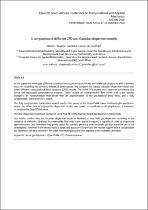JavaScript is disabled for your browser. Some features of this site may not work without it.
- ResearchSpace
- →
- Research Publications/Outputs
- →
- Conference Publications
- →
- View Item
| dc.contributor.author |
Bogaers, Alfred EJ

|
|
| dc.contributor.author |
Jansen van Rensburg, GJ

|
|
| dc.date.accessioned | 2018-10-23T12:40:09Z | |
| dc.date.available | 2018-10-23T12:40:09Z | |
| dc.date.issued | 2018-09 | |
| dc.identifier.citation | Bogaers, A.E.J. and Jansen van Rensburg, G.J. 2018. A comparison of different CFD and Gaussian dispersion models. Eleventh South African Conference on Computational and Applied Mechanics (SACAM 2018), Vanderbijlpark, South Africa, 17-19 September 2018 | en_US |
| dc.identifier.isbn | 978-1-77012-143-0 | |
| dc.identifier.isbn | 978-1-77012-144-7 | |
| dc.identifier.uri | http://hdl.handle.net/10204/10487 | |
| dc.description | Paper presented at the Eleventh South African Conference on Computational and Applied Mechanics (SACAM 2018), Vanderbijlpark, South Africa, 17-19 September 2018 | en_US |
| dc.description.abstract | In this paper we investigate different numerical techniques to approximate and model gas dispersion, with a primary focus on modelling the buoyancy effects of dense gasses. We compare the popular Gaussian dispersion model with three different computational fluid dynamics (CFD) models. The three CFD models vary based on complexity and hence the associated computational expense. These include an incompressible flow solver with scalar species transport, an incompressible flow solver with an approximation of the gravitational body force, and a fully compressible, combustion CFD model. The fully compressible, combustion model used in this paper is the OpenFOAM solver rhoReactingBuoyantFoam, where the other two incompressible dispersion models are based on modifications of pimpleFoam, a transient, incompressible OpenFOAM solver. The four dispersion models are compared using Trial 26, of the Thorney Island gas dispersion experiments. Our results confirm that the Gaussian dispersion model is ill-suited to near field gas dispersion modelling in the presence of obstacles. Similarly, incompressible flow with scalar specie transport, is capable of order of magnitude approximations, and therefore may prove useful for scenario planning when multiple gas-leak scenarios are to be investigated. However, if the density ratio is large, and accuracy is important, our results suggest that a compressible gas dispersion solver is necessary, for which rhoReactingBuoyantFoam appears to be a suitable candidate. | en_US |
| dc.language.iso | en | en_US |
| dc.relation.ispartofseries | Worklist;21443 | |
| dc.subject | Dense gas dispersion | en_US |
| dc.subject | OpenFOAM | en_US |
| dc.subject | CFD | en_US |
| dc.subject | Gaussian plume | en_US |
| dc.title | A comparison of different CFD and Gaussian dispersion models | en_US |
| dc.type | Conference Presentation | en_US |
| dc.identifier.apacitation | Bogaers, A. E., & Jansen van Rensburg, G. (2018). A comparison of different CFD and Gaussian dispersion models. http://hdl.handle.net/10204/10487 | en_ZA |
| dc.identifier.chicagocitation | Bogaers, Alfred EJ, and GJ Jansen van Rensburg. "A comparison of different CFD and Gaussian dispersion models." (2018): http://hdl.handle.net/10204/10487 | en_ZA |
| dc.identifier.vancouvercitation | Bogaers AE, Jansen van Rensburg G, A comparison of different CFD and Gaussian dispersion models; 2018. http://hdl.handle.net/10204/10487 . | en_ZA |
| dc.identifier.ris | TY - Conference Presentation AU - Bogaers, Alfred EJ AU - Jansen van Rensburg, GJ AB - In this paper we investigate different numerical techniques to approximate and model gas dispersion, with a primary focus on modelling the buoyancy effects of dense gasses. We compare the popular Gaussian dispersion model with three different computational fluid dynamics (CFD) models. The three CFD models vary based on complexity and hence the associated computational expense. These include an incompressible flow solver with scalar species transport, an incompressible flow solver with an approximation of the gravitational body force, and a fully compressible, combustion CFD model. The fully compressible, combustion model used in this paper is the OpenFOAM solver rhoReactingBuoyantFoam, where the other two incompressible dispersion models are based on modifications of pimpleFoam, a transient, incompressible OpenFOAM solver. The four dispersion models are compared using Trial 26, of the Thorney Island gas dispersion experiments. Our results confirm that the Gaussian dispersion model is ill-suited to near field gas dispersion modelling in the presence of obstacles. Similarly, incompressible flow with scalar specie transport, is capable of order of magnitude approximations, and therefore may prove useful for scenario planning when multiple gas-leak scenarios are to be investigated. However, if the density ratio is large, and accuracy is important, our results suggest that a compressible gas dispersion solver is necessary, for which rhoReactingBuoyantFoam appears to be a suitable candidate. DA - 2018-09 DB - ResearchSpace DP - CSIR KW - Dense gas dispersion KW - OpenFOAM KW - CFD KW - Gaussian plume LK - https://researchspace.csir.co.za PY - 2018 SM - 978-1-77012-143-0 SM - 978-1-77012-144-7 T1 - A comparison of different CFD and Gaussian dispersion models TI - A comparison of different CFD and Gaussian dispersion models UR - http://hdl.handle.net/10204/10487 ER - | en_ZA |






